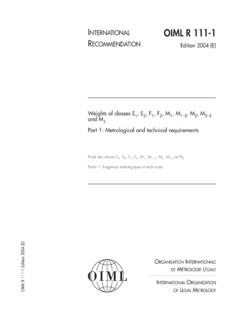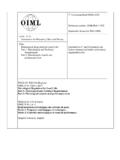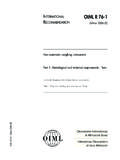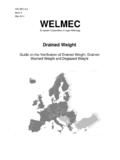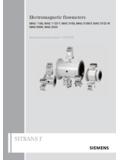Transcription of G ILAC-G24 I OIML D 10 S - etaloniranje
1 GUIDANCE ILAC-G24 INTERNATIONAL oiml D 10. SERIES Edition 2007 (E) DOCUMENT Edition 2007 (E). Guidelines for the determination of calibration intervals of measuring instruments Guide pour la d termination des intervalles de calibration des instruments de mesure INTERNATIONAL ORGANISATION INTERNATIONALE. DE METROLOGIE LEGALE. LABORATORY. ACCREDITATION. INTERNATIONAL ORGANIZATION. COOPERATION OF LEGAL METROLOGY. ILAC-G24 :2007 / oiml D 10:2007 (E). CONTENTS. Copyright ILAC .. 3. Foreword oiml .. 4. Preamble .. 5. Purpose .. 5. Authorship .. 5. 1. Introduction .. 5. 2. Initial choice of calibration intervals .. 7. 3. Methods of reviewing calibration intervals .. 7. Method 1: Automatic adjustment or staircase (calendar-time) ..8. Method 2: Control chart (calendar-time) .. 8.
2 Method 3: In-use time .. 9. Method 4: In service checking, or black-box testing .. 9. Method 5: Other statistical approaches .. 9. Bibliography .. 11. 2. ILAC-G24 :2007 / oiml D 10:2007 (E). Copyright (ILAC). ILAC-G24 :2007. Copyright ILAC 2007. ILAC encourages the authorized reproduction of its publications, or parts thereof, by organizations wishing to use such material for areas related to education, standardization, accreditation, good laboratory practice or other purposes relevant to ILAC's area of expertise or endeavor. Organizations seeking permission to reproduce material from ILAC publications must contact the ILAC Chair or Secretariat in writing or via electronic means such as e-mail. The request for permission should clearly detail: 1) the ILAC publication, or part thereof, for which permission is sought.
3 2) where the reproduced material will appear and what it will be used for;. 3) whether the document containing the ILAC material will be distributed commercially, where it will be distributed or sold, and what quantities will be involved;. 4) any other background information that may assist ILAC to grant permission. ILAC reserves the right to refuse permission without disclosing the reasons for such refusal. The document in which the reproduced material appears must contain a statement acknowledging ILAC's contribution to the document. ILAC's permission to reproduce its material only extends as far as detailed in the original request. Any variation in the stated use of the ILAC material must be notified in advance in writing to ILAC for additional permission. ILAC shall not be held liable for any use of its material in another document.
4 Any breach of the above permission to reproduce or any unauthorized use of ILAC material is strictly prohibited and may result in legal action. To obtain permission or for further assistance, please contact: The ILAC Secretariat c/o NATA. PO Box 7507. Silverwater NSW 2128. Australia Fax: +61 2 9743 5311. E-mail: 3. ILAC-G24 :2007 / oiml D 10:2007 (E). Foreword ( oiml ). The International Organization of Legal Metrology ( oiml ) is a worldwide, intergovernmental organization whose primary aim is to harmonize the regulations and metrological controls applied by the national metrological services, or related organizations, of its Member States. The main categories of oiml publications are: International Recommendations ( oiml R), which are model regulations that establish the metrological characteristics required of certain measuring instruments and which specify methods and equipment for checking their conformity.
5 oiml Member States shall implement these Recommendations to the greatest possible extent;. International Documents ( oiml D), which are informative in nature and which are intended to harmonize and improve work in the field of legal metrology;. International Guides ( oiml G), which are also informative in nature and which are intended to give guidelines for the application of certain requirements to legal metrology; and International Basic Publications ( oiml B), which define the operating rules of the various oiml . structures and systems. oiml Draft Recommendations, Documents and Guides are developed by Technical Committees or Subcommittees which comprise representatives from the Member States. Certain international and regional institutions also participate on a consultation basis.
6 Cooperative agreements have been established between the oiml and certain institutions, such as ISO and the IEC, with the objective of avoiding contradictory requirements. Consequently, manufacturers and users of measuring instruments, test laboratories, etc. may simultaneously apply oiml publications and those of other institutions. International Recommendations, Documents, Guides and Basic Publications are published in English (E) and translated into French (F) and are subject to periodic revision. Additionally, the oiml publishes or participates in the publication of Vocabularies ( oiml V) and periodically commissions legal metrology experts to write Expert Reports ( oiml E). Expert Reports are intended to provide information and advice, and are written solely from the viewpoint of their author, without the involvement of a Technical Committee or Subcommittee, nor that of the CIML.
7 Thus, they do not necessarily represent the views of the oiml . This publication - reference ILAC-G24 / oiml D 10, Edition 2007 - was developed by the ILAC Accreditation Committee and by oiml TC 4 Measurement standards and calibration and verification devices. This version supersedes oiml D 10 (Edition 1984). It was approved for final publication by ILAC in November 2005 and by the International Committee of Legal Metrology in 2002. oiml Publications may be downloaded from the oiml web site in the form of PDF files. Additional information on oiml Publications may be obtained from the Organization's headquarters: Bureau International de M trologie L gale 11, rue Turgot - 75009 Paris - France Telephone: 33 (0)1 48 78 12 82. Fax: 33 (0)1 42 82 17 27. E-mail: Internet: 4. ILAC-G24 :2007 / oiml D 10:2007 (E).
8 Guidelines for the determination of calibration intervals of measuring instruments Preamble This Guidance Document is a revision of oiml D 10. It was drafted by ILAC (International Laboratory Accreditation Cooperation) and the oiml (International Organization of Legal Metrology) as a joint venture and is published as such. It is important to point out that: It is not the responsibility of accreditation bodies to teach laboratories how to run their business. It is the responsibility of each individual laboratory to choose to implement any or none of the methods described in this Document based on its individual needs and its individual assessment of risks. It is also the responsibility of the laboratory to evaluate the effectiveness of the method it chooses to implement and take responsibility for the consequences of the decisions taken as a result of the method chosen.
9 Purpose The purpose of this Document is to give laboratories, particularly while setting up their calibration system, guidance on how to determine calibration intervals. This Document identifies and describes the methods that are available and known for the evaluation of calibration intervals. Authorship This publication was developed by the oiml and ILAC as a joint venture and as a revision of oiml . D 10. Within ILAC the focal point has been the Accreditation Committee. 1. Introduction An important aspect for maintaining the capability of a laboratory to produce traceable and reliable measurement results is a determination of the maximum period that should be permitted between successive calibrations (recalibrations) of the reference or working standards and measuring instruments used.
10 Various international standards take this aspect into account, : ISO/IEC 17025:2005 [1] contains the following requirements: Clause : Calibration programs shall be established for key quantities or values of the instruments where these properties have a significant effect on the results . Clause : "Whenever practicable, all equipment under the control of the laboratory and requiring calibration shall be labeled, coded, or otherwise identified to indicate the status of calibration, including the data when last calibrated and the date or expiration criteria when recalibration is due . Clause All equipment used for tests and/or calibrations, including equipment for subsidiary measurements ( for environmental conditions) having a significant effect on the accuracy or validity of the result of the test, calibration or sampling shall be calibrated before being put into service.



